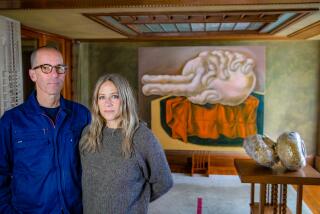The Father of the Relaxed and Easy Dinner Party
- Share via
When friends come over for dinner and pitch in to help set the table, or when they bring along a casserole to share, whether they know it or not, they’re following ideas popularized by Russel and Mary Wright in the 1940s and 1950s.
The revolutionary ideas of easy entertaining and relaxed home design put forward by the couple are the subject of “Russel Wright: Creating American Lifestyle” at New York City’s Cooper-Hewitt, National Design Museum, the first major retrospective of the work of the designer and his marketing-minded wife.
At the beginning of the 20th century, most design influences in America came from Europe. “There was the French Art Deco of the 1920s and the Scandinavian design in the early 1930s,” says Robert Schonfeld, co-curator with Donald Albrecht Schonfeld of the Wright show. Into this atmosphere came Russel Wright, who was determinedly American (he was related, on his mother’s side, to two signers of the Declaration of Independence) and created designs that celebrated America.
“People no longer lived in an upstairs-downstairs world,” says Schonfeld. “He and his wife, Mary, popularized the idea of making life easier. Even today their influence is pervasive.”
Mary and Russel Wright made life easier by designing and marketing products that were attractive, functional and affordable. Russel Wright, who started as a theatrical set designer in the 1920s, began designing for the home in the early 1930s. Beginning with simple shapes in his dinnerware and other items, he moved toward cool, metallic finishes with his spun aluminum line and finally to muted colors and organic forms in his mature work.
With Russel doing the designing and Mary doing the marketing, they promoted his name as a brand and a lifestyle for America to buy into. They coordinated all his lines, making it easy for the shopper to go to a store and look for his name to ensure that everything would go together. And this was long before today, when buying household-name products such as those of Martha Stewart and Ralph Lauren is common. “Mary was a member of the Einstein family, which included Albert, and she had ‘merchant genes,’” says Schonfeld. “Together they had artistic and marketing genius.”
Mary Wright died in 1952, Russel in 1976. After her death, he continued to work, but not with the prolific enthusiasm he had before.
His iconic American Modern dinnerware (1937) sold 80 million pieces over 20 years. They could all be mixed and matched, which made them versatile for the home. That was central to the Wrights’ idea expounded in their bestselling book, “Guide to Easier Living” (1950), which helped families set up homes in the newly built suburbs. The book defined the American lifestyle by stating that good informal living substituted a little headwork for a lot of legwork. “It doesn’t need wealth, but it does take thought, some ingenuity and resourcefulness, and more than a little loving care to create a home that is really your own,” they wrote.
Just how important Russel Wright is to modern design of today both stylistically and philosophically is easily seen in the exhibition. Besides dinnerware, Wright also designed furniture, appliances, textiles, interiors, buildings and landscapes. Highlights in the exhibit of more than 350 artifacts include tabletop vignettes, complete with Wright-designed dinnerware, flatware, linens and accessories; a multimedia presentation of Dragon Rock, Wright’s Modernist home; America’s first furniture in “blond” maple, a term that Mary Wright coined; and Wright-designed furnishings arranged in complete room settings.
The exhibit will remain at the Cooper-Hewitt at 2 E. 91st St. and 5th Avenue until Sept. 15. Information: (212) 849-8400 or www.si.edu/ndm.


